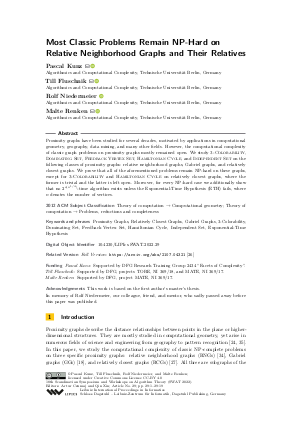@InProceedings{kunz_et_al:LIPIcs.SWAT.2022.29,
author = {Kunz, Pascal and Fluschnik, Till and Niedermeier, Rolf and Renken, Malte},
title = {{Most Classic Problems Remain NP-Hard on Relative Neighborhood Graphs and Their Relatives}},
booktitle = {18th Scandinavian Symposium and Workshops on Algorithm Theory (SWAT 2022)},
pages = {29:1--29:19},
series = {Leibniz International Proceedings in Informatics (LIPIcs)},
ISBN = {978-3-95977-236-5},
ISSN = {1868-8969},
year = {2022},
volume = {227},
editor = {Czumaj, Artur and Xin, Qin},
publisher = {Schloss Dagstuhl -- Leibniz-Zentrum f{\"u}r Informatik},
address = {Dagstuhl, Germany},
URL = {https://drops.dagstuhl.de/entities/document/10.4230/LIPIcs.SWAT.2022.29},
URN = {urn:nbn:de:0030-drops-161891},
doi = {10.4230/LIPIcs.SWAT.2022.29},
annote = {Keywords: Proximity Graphs, Relatively Closest Graphs, Gabriel Graphs, 3-Colorability, Dominating Set, Feedback Vertex Set, Hamiltonian Cycle, Independent Set, Exponential-Time Hypothesis}
}

 Creative Commons Attribution 4.0 International license
Creative Commons Attribution 4.0 International license


